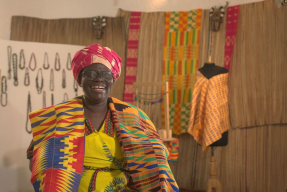Should you lend via Kiva’s for-profit Field Partners?
April 21, 2010
By Rosalind Piggot, KF10, Tajikistan
Following the recent New York Times article questioning the interest rates charged in microfinance, I looked back at recent blogs by Kiva Fellows about interest rates and sustainability. In comments on those blogs and on Kiva’s lender team sites, a lot of people were asking: “Do I want to lend via a for-profit institution?” and similar questions.
As a fellow in Tajikistan, I don’t think for-profit status undermines social mission. Why?
1.The other side of borrowing is saving
Lending on Kiva is about enabling people to access credit. But the same entrepreneurs that need credit might also want access to checking and savings accounts.
The problem is that if you are a non-profit microfinance organization in Tajikistan, you cannot offer savings services. Under Tajik regulations, joint stock companies or limited liability companies can be registered as deposit-taking institutions, but not non-profits. Since deposit organizations hold the public’s money, sustainability is necessary so depositors can be sure their savings will be there in the longer term.
As with microfinance generally, there is much debate over the role that micro-savings play in alleviating poverty (you can visit CGAP for case studies). But savings products can help reach out to individuals that do not have the appetite to take on the risk of credit. And, unlike using credit, there is no interest to pay when withdrawing savings to cover costs. In a sense, transitioning to a for-profit in Tajikistan can enable a microfinance institution to serve new, under-served groups and help low income savers access cheaper funds.
2.Where do the profits go?
On average, the Return on Assets of Kiva’s Field Partners is near to nil. Some of Kiva’s Partners do, however, make profits.
In Tajikistan, I was interested to discover that major (if not majority) shareholders of Kiva’s for-profit Partners are actually non-profits that work locally. These non-profits are dedicated to assisting women entrepreneurs or establishing other types of social outreach programs. If Kiva’s for-profit Field Partners distribute profits (currently, any earnings are generally reinvested in the Field Partners’ businesses), the non-profits benefit. In this way, profits stay in the sphere of social outreach. For me, this makes the distinction between for-profit and non-profit less clear than I imagined.
So…
As mentioned in Dennis’ recent blog, I agree that social investors are critical to determining microfinance’s future. Kiva screens its Field Partners. Lenders who want to conduct additional research should do so too. I hope my own research on Tajikistan will be helpful when you decide how to lend, so let me know your thoughts!
If you would like to support entrepreneurs in Tajikistan, you can lend, join the team Supporters of Tajikistan, or learn more about Tajikistan from Kiva Fellow blog posts














